An emission-free ‘nuclear powered’ 984ft-long science exploration vessel, as large as the world’s longest cruise ship will launch in 2025 with 22 cutting edge laboratories and over 400 people on board.
The Earth 300 vessel has been designed to ‘unite science and exploration to confront Earth’s greatest challenges,’ according the founder of Iddes Yacht, manufacturer of the ship, Salas Jefferson, who says it will cater for about 160 scientists at one time.

The ship will be packed with green technology, a ‘science sphere’, and will be powered by a Molten Salt Reactor, a type of nuclear power generator that uses molten fluoride salts as a coolant and operates at low pressure.
When launched, it will act as an ‘extreme technology platform for science, exploration and innovation at sea’, according to Iddes, who say its 22 laboratories will be equipped with robotics and artificial intelligence systems.
An emission-free ‘nuclear powered’ 984ft-long science exploration vessel, as large as the world’s longest cruise ship will launch in 2025 with 22 cutting edge laboratories and over 400 people on board.
The Iddes Yacht vessel has been designed to ‘unite science and exploration to confront Earth’s greatest challenges,’ according founder Salas Jefferson, who says it will cater for about 160 scientists at one time.
The ship will be packed with green technology, a ‘science sphere’, and will be powered by a Molten Salt Reactor, a type of nuclear power generator that uses molten fluoride salts as a coolant and operates at low pressure
THE EARTH 300 IN NUMBERS:
Length: 300 metres
Width: 46 metres
Height: 60 metres
22 Laboratories
20 VIP Cabins
160 Scientists
20 Experts-in-Residence
20 Students
40 VIP Guests
165 Crew
Featuring naval architecture by the NED Project, Earth 300 will introduce ‘features found on cruise, expedition, research and luxury yachts but she will be none of them,’ said Earth 300 chief executive Aaron Olivera.
The firm behind the design say it will have a ‘science city’ inside a huge sphere, an observation deck and an interior dedicated to scientific research and expedition.
The design phase for the vessel is done, with construction due to begin soon on the massive floating city that will be larger than the Titanic and about the length of three soccer pitches.
The Earth 300 will also carry a fleet of advanced underwater vessels to help with deep-sea studies, and a helicopter to allow people to travel to and from the ship and explore the ocean fro the air, according to Jefferson.
‘We wanted to create a design that would inspire. When one looked at the sphere, we wanted them to be inspired to protect Earth,’ he said in a statement.
‘When one would walk into the sphere, now housing the science city, and felt the action of all the ongoing scientific works, we wanted them to be inspired to become an alchemist of global solutions.’
Accommodation will be for a total of 160 scientists, 20 experts-in-residence, 20 students, 40 VIP guests and 165 crew to support the residents and visitors on board.
When launched it will act as an ‘extreme technology platform for science, exploration and innovation at sea’, according to Iddes, who say its 22 laboratories will be equipped with robotics and artificial intelligence systems.
Featuring naval architecture by the NED Project, Earth 300 will introduce ‘features found on cruise, expedition, research and luxury yachts but she will be none of them,’ said Earth 300 chief executive Aaron Olivera.
The vision is that the leading scientists on board will be working in collaboration to bring rapid, far-reaching solutions to market, according to the website for Earth 300.
‘At the same time, it offers an open source platform for the global scientific community to take advantage of, as well as providing a backdrop for citizen science and intrepid, meaningful exploration.’
There are a number of areas the ship and its crew plan to explore, including water and food security, climate catastrophes, education and global health resilience.
‘Food security depends on water security, they’re inextricably linked. The world is running out of clean, fresh water to feed and nourish a growing global population and maintain the health of our planet,’ the firm said.
The design phase for the vessel is done, with construction due to begin soon on the massive floating city that will be larger than the Titanic and about the length of three soccer pitch.
The vision is that the leading scientists on board will be working in collaboration to bring rapid, far-reaching solutions to market, according to the website for Earth 300.
There are a number of areas the ship and its crew plan to explore, including water and food security, climate catastrophes, education and global health resilience.
‘Covid-19 has acted like a stress test on every aspect of life, it has particularly exposed weaknesses in global health systems. It’s important to learn the right lessons with regard to preparedness, capacity and future resilience.
Earth 300 promises to be an important repository of data and information for planet Earth. We’re providing an open platform for science and innovation that can be accessed on a global scale.’
Led by chief executive Olivera, the Earth 300 project is supported by a number of partners including IBM, RINA, Triton Submarines and EYOS Expeditions.
The preliminary vessel design and naval engineering are now complete, with Earth 300 projecting a launch date of 2025.
Visit original web page here


